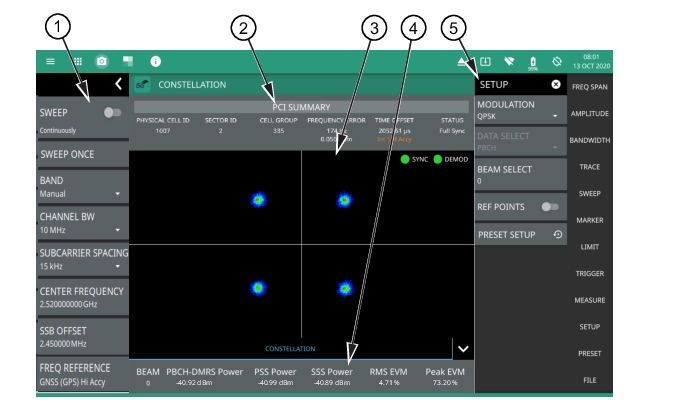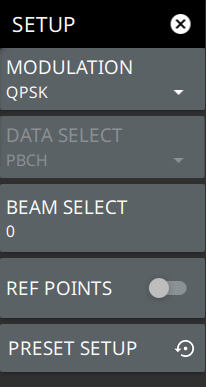 |
1. 5GNR Analyzer Status Panel: Each measurement features a unique status panel that displays settings and information relevant to the current measurement and view settings. This panel provides quick access to the measurement frequency, subcarrier spacing, channel bandwidth, and band configuration. See Status Panel (5GNR Constellation). 2. PCI Summary: This area shows the physical cell ID summary data, including the sector ID, cell group number, frequency error, time offset, and sync status. Sync status can indicate if there is a PSS, SSS, or Beam Index failure, Full Sync, or an Unknown condition. Also noted is the instrument’s reference clock accuracy of Internal, External, or GNSS (GPS) high accuracy (requires GPS). 3. Constellation: This area displays the demodulated symbol point location on an IQ coordinate plot. Points are drawn in colors that are associated with the symbol point density. Warmer colors (red/orange) indicate a higher symbol density where cooler colors (cyan/blue) indicate lower symbol density. The ideal symbol reference point location overlay can be toggled on or off via the SETUP menu. 4. Channel Summary: For the currently selected beam, shows the RMS error vector magnitude (EVM), peak EVM (@ subcarrier/symbol) and received power in dBm for each block measurement: • Beam: Shows the value of the selected 5GNR SSB beam. • PBCH-DMRS Power: In 5GNR measurements, the PBCH decoding relies on a demodulation reference signal (DMRS, which is a physical layer reference signal used for decoding) rather than a cell specific reference signal (CRC). • PSS Power: The primary synchronization signal provides the primary frame boundary (i.e., the position of the first symbol in the frame). • SSS Power: Similar to PSS, the secondary synchronization signal provides the secondary sub-frame boundary. • RMS EVM: Shows the percentage value of all the error vectors between the reconstructed ideal signals and the received signals divided by the RMS value of the ideal signals. • Peak EVM: Shows the dominant cell’s peak EVM of all the error vectors between the reconstructed ideal signals and the received signals, divided by the RMS value of the ideal signals. 5. SETUP Menu: The constellation measurement settings are configured in the SETUP menu. See SETUP Menu (5GNR Constellation). |

